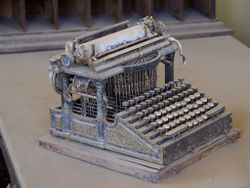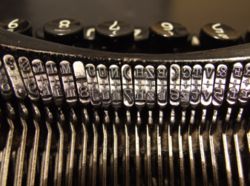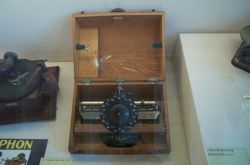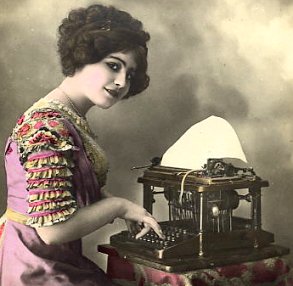Typewriter
2007 Schools Wikipedia Selection. Related subjects: Engineering

A typewriter is a mechanical, electromechanical, or electronic device with a set of "keys" that, when pressed, cause characters to be printed on a document, usually paper.
In the late 19th and the start of the 20th century a person who operated such a device was sometimes also called a typewriter but it then became more common to call the person a typist.
For much of the 20th Century, typewriters were indispensable tools in business offices and for many (if not most) professional writers. By the 1980s, however, word processor applications on personal computers largely overtook the tasks previously done with typewriters. However, typewriters are still popular in the developing world, and among some niche markets.
As of 2006, the following companies manufacture typewriters and accessories: Smith-Corona, Olivetti, Adler-Royal, Olympia, Brother, and Nakajima. Olivetti is the only western company to currently manufacture manual typewriters. All other current models are electronic.
History
Early Innovations
No one person can be said to have invented the typewriter. As with the light bulb, automobile, telephone, and telegraph, a number of people contributed insights and inventions that eventually resulted in commercially successful instruments. In 1714 Henry Mill obtained a patent in Britain for a machine that from the patent sounds similar to a typewriter, but nothing further is known. Other early developers of writing machines include Pellegrino Turri (1808), who also invented carbon paper. Many of these earliest machines, including Turri's, were developed to enable the blind to write.
In 1829 William Austin Burt patented a machine called the "Typographer." Like many other early machines, it is sometimes listed as the "first typewriter"; the Science Museum (London) describes it merely as "the first writing mechanism whose invention was documented," but even that claim may be excessive, since Turri's machine is well known. Even in the hands of its inventor, it was slower than handwriting. Burt and his promoter John D. Sheldon never found a buyer for the patent, and it was never commercially produced. Because it used a dial to select the character instead of having an individual key for each character, it was an "index typewriter" rather than a "keyboard typewriter," if it is to be considered a typewriter at all. From 1829 to 1870, many printing or typing machines were patented by inventors in Europe and America, but none went into commercial production. Charles Thurber developed multiple patents; his first, in 1843, was developed as an aid to the blind. See Charles Thurber's 1845 Chirographer, as an example.
In 1855 the Italian Giuseppe Ravizza created a prototype typewriter called "Cembalo scrivano o macchina da scrivere a tasti." It was an advanced machine that let the user see the writing as it was typed.
Father Francisco João de Azevedo, a Brazilian priest, made his own typewriter in 1861 with poor materials, such as wood and knives. D. Pedro I, the Brazilian emperor, in that same year, presented a gold medal to Father Azevedo for this invention. Many Brazilian people as well as Brazilian federal government recognize Fr. Azevedo as the real inventor of the typewriter, a claim that has been the subject of controversy.
The Austrian Peter Mitterhofer created a typewriter in 1864, but it was never produced commercially. Mitterhofer continued to improve his original model and created five different enhanced typewriters until 1868.
In 1865 Rev. Rasmus Malling-Hansen of Denmark invented the Hansen Writing Ball, which went into commercial production in 1870 and was the first commercially sold typewriter. It was a success in Europe and was reported being used in offices in London as late as 1909. Additionally, Malling-Hansen used a solenoid escapement to return the carriage on some of his models and was responsible for the first "electric" typewriter. From the book Hvem er Skrivekuglens Opfinder?, written by Malling-Hansen's daughter Johanne Agerskov, we know that Malling-Hansen in 1865 made a porcelain model of the keyboard of his writing ball and experimented with different placements of
the letters to achieve the fastest writing speed. Malling-Hansen placed the letters on short pistons that went directly through the ball and down to the paper, and this, together with placement of the letters so that the fastest writing fingers struck the most frequently used letters, made the Hansen Writing Ball the first typewriter to produce text substantially faster than a person could write by hand. Malling-Hansen developed his typewriter further through the 1870s and 1880s and made many improvements, but the writing head remained the same. On the first model of the writing ball from 1870, the paper was attached to a cylinder inside a wooden box. In 1874 the cylinder was replaced by a carriage, moving underneath the writing head. Then, in 1875, the well-known, tall model was patented, and it was the first of the writing balls that worked without electricity. Malling-Hansen attended the world exhibitions in Vienna in 1873 and Paris in 1878. At both places, he received the first-prize medals for his invention.
In 1867 Christopher Sholes, Carlos Glidden, and Samuel W. Soule invented another typewriter. The patent (US 79,265) was sold for $12,000 to Densmore and Yost, who made an agreement with E. Remington and Sons (then famous as a manufacturer of sewing machines) to commercialize what was known as the Sholes and Glidden Type-Writer. Remington started production of their first typewriter on March 1, 1873, in Ilion, New York. Another early typewriter manufacturer was Underwood.
The ability to view what is typed as it is typed is taken for granted today. In all early keyboard typewriters, however, the typebars struck upwards against the bottom of the platen. Thus, what was typed was not visible until the typing of subsequent lines caused it to scroll into view. The difficulty with any other arrangement was ensuring that the typebars fell back into place reliably when the key was released. This was eventually achieved with ingenious mechanical designs, and so-called "visible typewriters" were introduced in 1895. Surprisingly, the older style continued in production as late as 1915.
Standardization
By about 1920, the "manual" or "mechanical" typewriter had reached a more or less standardized design. There were minor variations from one manufacturer to another, but most typewriters followed the design noted below:
Each key was attached to a typebar that had the corresponding letter molded into its other end. When a key was struck briskly and firmly, the typebar hit a ribbon (usually made of inked fabric) stretched in front of a cylindrical platen that moved back and forth. The paper was rolled around by the typewriter's platen, which was then rotated by a lever (the "carriage return" lever at the far left) to each new line of text. Some ribbons were inked in black and red, each a stripe half the width and the entire length of the ribbon. A lever on most machines allowed switching between colors for typing bookkeeping entries, where negative amounts had to be in red.
Electric designs
Though electric typewriters would not achieve widespread popularity until nearly a century later, the basic groundwork for the electric typewriter was laid by the Universal Stock Ticker, invented by Thomas Edison in 1870. This device remotely printed letters and numbers on a stream of paper tape from input generated by a specially designed typewriter at the other end of a telegraph line.
The first electric typewriter was produced by the Blickensderfer Manufacturing Company, of Stamford, Connecticut, in 1902. While never marketed commercially, this was the first known typewriter to use a typewheel rather than individual typebars, although the element was cylindrical rather than ball-shaped. The next step in the development of the electric typewriter came in 1909, when Charles and Howard Krum file a patent for the first practical teletype machine in 1909. The Krum's machine also used a typewheel rather than individual typebars. While innovative, neither of these machines reached the business or personal consumer.
Electrical typewriter designs removed the direct mechanical connection between the keys and the element that struck the paper. Not to be confused with later electronic typewriters, electric typewriters contained only a single electrical component: the motor. Where the keystroke had previously moved a typebar directly, now it engaged mechanical linkages that directed mechanical power from the motor into the typebar. This was also true of the forthcoming IBM Selectric.
IBM and Remington electric typewriters were the leading models until IBM introduced the IBM Selectric typewriter, which replaced the typebars with a spherical typeball (more correctly, "element"), slightly larger than a golf ball, with the letters molded on its surface. The Selectric used a system of latches, metal tapes, and pulleys driven by an electric motor to rotate the ball into the correct position and then strike it against the ribbon and platen. The typeball moved laterally in front of the paper instead of the former platen-carrying carriage moving the paper across a stationary print position.
The typeball design had many advantages, especially in eliminating of "jams" when more than one key was struck at once, and in the ability to change the typeball, allowing multiple fonts to be used in a single document. Selectric mechanisms were widely incorporated into computer terminals in the 1970s, because the typing mechanism was reasonably fast and jam-free; could produce very high quality output compared to competitors such as Teletype machines, could be initiated by a short, low-force mechanical action; did not require the movement of a heavy "type basket" in order to shift between lower- and upper-case; and did not require the platen roller assembly to move from side to side (which would be a problem with continuous-feed paper). The IBM 2741 terminal was a very popular example of a Selectric-based computer terminal, and similar mechanisms were employed as the console devices for many IBM System/360 computers. These mechanisms did use "ruggedized" designs compared to those in standard commercial typewriters.
Later models of IBM Executives and Selectrics replaced inked fabric ribbons with "carbon film" ribbons that had a dry black or colored powder on a "once-through" clear plastic tape. These could be used only once but later models used a cartridge that was simple to replace. A side effect of this technology is that the text typed on the machine can be easily read from the used ribbon. This "feature" raised issues where the machines were used for preparing classified documents; ribbons had to be accounted for to ensure that typists didn't walk out with them in pockets or purses. A document reconstructed from a used carbon ribbon was portrayed as the key to solving a crime in an episode of Columbo.
A variation known as "Correcting Selectrics" introduced correction, where a sticky tape in front of the print ribbon could remove the black-powdered image of a typed character, and introduced selectable "pitch" so that the typewriter could be switched among pica ("10 pitch", or 10 characters per inch) and elite ("12 pitch"), even in one document. Even so, all Selectrics were monospaced—each and every character was allotted the same horizontal space on the page. Although IBM had produced a successful typebar-based machine, the IBM Executive, with proportional spacing, no proportionally spaced Selectric office typewriter was ever introduced. There was, however, a much more expensive proportionally spaced machine called the Selectric Composer which was capable of right-margin justification and so was considered a typesetting machine rather than a typewriter, and the more reasonably priced IBM Electronic Typewriter 50, which was capable of proportional spacing but not justifying.
The final major development of the typewriter was the "electronic" typewriter. Most of these replaced the typeball with a daisy wheel mechanism (a disk with the letters molded on the outside edge of the "petals"). A plastic daisy-wheel was much simpler and cheaper than the typeball but wore out more easily. Some electronic typewriters were in essence dedicated word processors with internal memory and cartridge or diskette external memory-storage devices. Unlike the Selectrics and earlier models, these really were "electronic" and relied on integrated circuits and multiple electromechanical components.
Computer/typewriter hybrids
Towards the end of the commercial popularity of typewriters in the 1980s, a number of hybrid designs combining features of computer printers and typewriters were introduced.
These typically incorporated keyboards from existing models of typewriters and the printing mechanism of dot-matrix printers. The generation of teletypes with impact pin-based printing engines was not adequate for the demanding quality required for typed output. Newly developed, thermal transfer technologies used in thermal label printers had become technically feasible for typewriters.
IBM produced a series of typewriters called Thermotronic with letter-quality output and correcting tape along with printers tagged Quietwriter. Brother extended the life of their typewriter product line with similar products. DEC meanwhile had the DECwriter.
The development of these proprietary printing engines provided the vendors with exclusive markets in consumable ribbons and the possibility to use standardised printing engines with varying degrees of electronic and software sophistication to develop product lines.
The increasing dominance of personal computers and the introduction of low-cost, truly high-quality, laser and inkjet printer technologies are replacing typewriters.
Typewriter legacy
Today, with the proliferation of the personal computer with word processing software, typewriters would seem to have faded into near-obscurity. However typewriters were commonly used in professional offices (lawyers, doctors, schools, etc.) for specialized applications such as filling out pre-printed forms, addressing envelopes, and writing letters. However, in recent years computer programs have enabled computer users to accomplish most or all of these tasks.
The monospaced, stark, and slightly uneven look of typewritten text can have some artistic appeal, and some people, young or old, prefer to use a typewriter.
In some less developed countries, where personal computers are not ubiquitous, one may find public spaces with individuals who rent out their services as on-the-spot letter writers, accepting dictation from their customers, who may be illiterate or who simply do not own a typewriter. In Mexico, for example, such a thing can be seen daily on Calle Heroes de Cañonero in downtown Tampico.
Keyboard layout
The 1874 Sholes & Glidden typewriters established the QWERTY layout for the letter keys. During the period in which Sholes and his colleagues were experimenting with this invention, other keyboard arrangements were apparently tried, but these are poorly documented. The tantalizing near-alphabetical sequence on the "home row" of the QWERTY layout (d-f-g-h-j-k-l) demonstrates that a straightforward alphabetical arrangement was the original starting point . The QWERTY layout of keys has become the de facto standard for English-language typewriter and computer keyboards. Other languages written in the Latin alphabet may use variants of the QWERTY layouts, such as the French AZERTY, the Italian QZERTY, the German QWERTZ, and the Portuguese HCESAR layouts.
The QWERTY layout is certainly far from the most efficient, since it requires a touch-typist to move his or her fingers between rows to type the most common letters. A popular story suggests that it was used for early typewriters because it was inefficient; it slowed a typist down so as to reduce the frequency of the typewriter's typebars' wedging together and jamming the machine. A more likely explanation is that the QWERTY arrangement was designed to reduce the likelihood of internal clashing by placing commonly used combinations of letters farther away from each other inside the machine . This allowed the user to actually type faster without jamming. Unfortunately, no definitive explanation for the QWERTY keyboard has been found, and typewriter aficionados continue to debate the issue.
A number of radically different layouts, such as the Dvorak keyboard, have been proposed to reduce the perceived inefficiencies of QWERTY, but these have not been able to displace the QWERTY layout; their proponents claim considerable advantages, but so far none has been widely used. The Blickensderfer typewriter with its DHIATENSOR layout may have possibly been the first attempt at optimizing the keyboard layout for efficiency advantages.
Many old typewriters do not contain a separate key for the numeral 1, and some even older ones also lack the numeral zero. Typists learned the habit of using the lowercase letter l for the digit 1, and the uppercase O for the zero. Some still carry the habit of using the letter l instead of the numeral 1 with them when typing on a computer, sometimes leading to errors, especially when working with numerical data.
Computer jargon
Several words of the 'typewriter age' have survived into the personal computer era. Examples include:
- carbon copy – now in its abbreviated form "CC" designating copies of email messages (with no carbon involved, at least not until potential printouts);
- cursor – a marker used to indicate where the next character will be printed
- carriage return (CR) – indicating an end of line and return to the first column of text (and on some computer platforms, advancing to the next line)
- line feed (LF), aka 'newline' – standing for moving the cursor to the next on-screen line of text in a word processor document (and on the eventual printout(s) of the document).
Correction methods
According to the standards taught in secretarial schools in the mid- 1900s, a business letter was supposed to have no mistakes and no visible corrections. Accuracy was prized as much as speed. Indeed, typing speeds, as scored in proficiency tests and typewriting speed competitions, included a deduction of ten words for every mistake that was made.
Corrections were, of course, necessary, and a variety of methods and technologies were used.
The traditional method involved the use of a special typewriter eraser. The typewriter eraser was made of fairly hard, stiff rubber, containing abrasive material. It was in the shape of a thin, flat disk, approx. 2 inches (50 mm) in diameter by 1/8 inch (3 mm) thick allowing for the erasure of individual typed letters. Business letters were typed on heavyweight, high-rag-content bond paper, not merely to provide a luxurious appearance, but also to stand up to erasure. Typewriter erasers were equipped with a brush for brushing away eraser crumbs and paper dust, and using the brush properly was an important element of typewriting skill, because if erasure detritus fell into the typewriter, a very small buildup could cause the typebars to jam in their narrow supporting grooves.
Erasing a set of carbon copies was particularly difficult, and called for the use of a device called an eraser shield to prevent the pressure of erasure on the upper copies from producing carbon smudges on the lower copies.
Paper companies produced a special form of typewriter paper called erasable bond (for example, Eaton's Corrasable Bond). This incorporated a thin layer of material that prevented ink from penetrating and was relatively soft and easy to remove from the page. An ordinary soft pencil eraser could quickly produce perfect erasures on this kind of paper. However, the same characteristics that made the paper erasable made the characters subject to smudging due to ordinary friction and deliberate alteration after the fact, making it unacceptable for business correspondence, contracts, or any archival use.
In the 1950s and 1960s, correction fluid made its appearance, under brand names such as Liquid Paper, Wite-Out and Tipp-Ex. This was a kind of opaque white fast-drying paint which produced a fresh white surface onto which a correction could be re-typed. However, when held to the light, the covered-up characters were visible, as was the patch of dry correction fluid (which was never perfectly flat, and never a perfect match for the colour, texture, and luster of the surrounding paper). The standard trick for solving this problem was photocopying the corrected page, but this was possible only with high quality photocopiers, and was not practical with color letterheads. (However, high quality typists were smart enough to place the color letterhead stock in the copier, and photocopy the corrected typed-text-only-on-plain-paper document onto the colour letterhead.)
Dry correction products (such as correction paper) under brand names such as "Ko-Rec-Type" were introduced in the 1970s and functioned like white carbon paper. A strip of the product was placed over the letters needing correction, and the incorrect letters were retyped, causing the black character to be overstruck with a white overcoat. Similar material was soon incorporated in carbon-film electric typewriter ribbons; like the traditional two-colour black-and-red inked ribbon common on manual typewriters, a black/white correcting ribbon became commonplace on electric typewriters.
The pinnacle of this kind of technology was the IBM Electronic Typewriter series. These machines, and similar products from other manufacturers, used a separate correction ribbon and a character memory. With a single keystroke, the typewriter was capable of automatically reversing and overstriking the previous characters with minimal marring of the paper. White cover-up or plastic lift-off correction ribbons are used with fabric ink or carbon film typing ribbons, respectively.
Typing speed records and speed contests
During the 1920s through 1940s, typing speed was an important secretarial qualification and typing contests were popular, publicized by typewriter companies as promotional tools.
As of 2005, Barbara Blackburn is the fastest typist in the world, according to The Guinness Book of World Records. Using the Dvorak Simplified Keyboard, she has maintained 150 word/min for 50 min and 170 word/min for shorter periods and has been clocked at a peak speed of 212 word/min. Blackburn, who failed her typing class in high school, first encountered the Dvorak keyboard in 1938, quickly learned to achieve very high speeds, and occasionally toured giving speed-typing demonstrations during her secretarial career. She appeared on The David Letterman Show and was deeply offended by Letterman's comedic treatment of her skill.
Popular software named " Mavis Beacon Teaches Typing" had led many people to assume that there is a woman named Mavis Beacon who is a very good typist. In reality, Mavis Beacon is a fictional promotional character.
Forensic identification
Because of the tolerances of the mechanical parts, slight variation in the alignment of the letters and their uneven wear, each typewriter has its individual "signature" or " fingerprint", allowing a typewritten document to be tracked back to the typewriter it was produced on. In the Eastern Bloc, typewriters (together with printing presses, copy machines, and later computer printers) were a controlled technology, with secret police in charge of maintaining files of the typewriters and their owners. (In the Soviet Union, the organization in charge of typewriters was the First Department of the KGB.) This posed a significant risk for dissidents and samizdat authors. This method of identification was also used in the trial of Alger Hiss.
Black/white computer printers have their "fingerprints" as well, but to lesser degree. Modern colour printers and photocopiers typically add printer identification encoding -- a steganographic pattern of minuscule yellow dots, encoding the printer's serial number -- to the printout.
Other forensic identification method can involve analysis of the ribbon ink.










